Bighorn National Forest
- January 3, 2024
- 4 comment
Bighorn National Forest is a vast expanse of natural beauty, located in the Bighorn Mountains of Wyoming. This area covers over one million acres of land, featuring breathtaking landscapes, untarnished wilderness, and crystal-clear streams. The park’s undisturbed environment presents a haven for outdoor enthusiasts and nature lovers, offering various activities such as hiking, camping, fishing, and wildlife viewing.

Additionally, the park holds a storied history, with archaeological findings indicating human habitation dating back over ten millennia. Presently, Bighorn National Forest remains a cherished destination, providing a respite for individuals seeking to escape the bustle of modern life and indulge in the serenity of the great outdoors.
Characterizing Features of the Bighorn National Forest
- Vast and Diverse Landscape: Bighorn National Forest spans over one million acres of varied terrain, encompassing scenic mountains, valleys, and alpine tree forests. From the lowlands covered in sagebrush to the towering peaks of the Bighorn Mountains, the landscape caters to a wide range of outdoor enthusiasts. This diversity makes the forest an ideal destination for hikers and bikers seeking both challenging trails and serene paths.
- Cloud Peak Wilderness: Within the expansive forest lies the Cloud Peak Wilderness, a pristine area covering 189,000 acres that strictly prohibits motorized or mechanical equipment. Accessible solely by foot or horseback, this untouched wilderness provides a unique opportunity for visitors to immerse themselves in unspoiled nature. The designation ensures a tranquil and undisturbed environment for those seeking a more rugged and secluded outdoor experience.
- Extensive Trail System: With a network of 1,500 miles of trails crisscrossing the landscape, Bighorn National Forest caters to outdoor enthusiasts of all levels. These trails lead adventurers through diverse ecosystems, offering breathtaking views and opportunities to encounter the rich flora and fauna of the region. Whether a day hike or a more extended backpacking excursion, the forest provides a myriad of trail options for exploration.
- Historical Significance: Established in 1897 as the Big Horn National Forest, Bighorn holds the distinction of being one of the oldest government-protected forest lands in the U.S. Over the years, it has evolved and expanded, maintaining its significance in preserving the natural beauty of the region. The forest’s rich history is palpable, adding an extra layer of depth to the visitor’s experience.
- Scenic Byways: Bighorn National Forest is traversed by scenic byways, including the Bighorn Scenic Byway (U.S. Route 14) and the Cloud Peak Skyway (U.S. Route 16). These routes not only provide stunning vistas of the surrounding landscapes but also offer convenient access to key points of interest within the forest. The byways enhance the visitor experience by combining the joy of exploration with the ease of navigation.
- Abundance of Lakes: The forest is dotted with numerous lakes, contributing to its allure and providing recreational opportunities. Meadowlark Lake, created by a dam built in 1936, is a popular spot for activities such as fishing and boating. The lakes not only add scenic beauty to the landscape but also support diverse aquatic ecosystems, making them a focal point for nature enthusiasts.
- Wildlife Habitat: Bighorn National Forest is a haven for wildlife, including black bears, cougars, elk, mule deer, and moose. The forest’s diverse ecosystems, ranging from lodgepole pine forests to alpine meadows, provide habitats for a variety of species. The resurgence of grizzly bears in recent decades adds an element of ecological significance, highlighting the forest’s role in supporting biodiversity.
- Strategic Visitor Centers: Visitor centers at Burgess Junction and near Shell Falls serve as gateways to the forest, offering information, maps, and educational resources. These centers not only enhance the visitor experience but also play a crucial role in promoting conservation awareness. Burgess Junction, with its ranger station, accommodations, and campgrounds, serves as a strategic hub for those exploring the heart of Bighorn National Forest.
History
Bighorn National Forest, with its rich history dating back to the late 19th century, stands as a testament to the enduring commitment to preserving the natural beauty of the American West. Established on February 22, 1897, as the Big Horn National Forest, it holds the distinction of being one of the oldest government-protected forest lands in the United States. Initially spanning 1,198,080 acres, the forest’s name changed on July 1, 1908, becoming the Bighorn National Forest through an executive order. Over the years, the forest’s boundaries have evolved, and by September 1981, it encompassed 1,115,171 acres, with 1,107,670 of those acres designated as National Forest land.
Located in northern Wyoming, the forest extends for 80 miles along the spine of the Bighorn Mountains, an outlying range separated from the main Rocky Mountains by the Bighorn Basin. The area’s diverse ecosystems, ranging from sagebrush-covered lowlands to the towering Cloud Peak, attracted early conservation efforts, leading to its designation as a U.S. Forest Reserve in 1897.

The Cloud Peak Wilderness was established to protect 189,000 acres from motorized or mechanical intrusion, ensuring that this pristine wilderness remains untouched by modern technology. This area, accessible only on foot or horseback, serves as a sanctuary for those seeking a more immersive and undisturbed connection with nature.
Throughout its history, Bighorn National Forest has played a pivotal role in providing recreational opportunities for visitors. The forest boasts an extensive trail system covering 1,500 miles, catering to hikers, bikers, and nature enthusiasts of all levels. Scenic byways, including the Bighorn Scenic Byway and the Cloud Peak Skyway, offer breathtaking views and convenient access to key points of interest within the forest.
Today, the forest headquarters is located in Sheridan, Wyoming, overseeing local ranger district offices in Buffalo, Lovell, and Sheridan. Visitor centers at strategic locations, such as Burgess Junction and near Shell Falls, serve as gateways to the forest, providing valuable information and educational resources. Bighorn National Forest continues to be a living testament to the enduring spirit of conservation, offering a timeless and immersive experience in the heart of the Rocky Mountains.
Importance in Conservation and Recreation of Bighorn National Forest
Bighorn National Forest holds profound importance in the realms of conservation and recreation, embodying a harmonious balance between preserving natural ecosystems and providing unparalleled recreational opportunities. As one of the oldest government-protected forest lands in the United States, the forest serves as a vital stronghold for biodiversity. Its diverse ecosystems, ranging from lodgepole pine forests to alpine meadows, provide crucial habitats for a variety of wildlife, including black bears, cougars, elk, mule deer, and moose. The resurgence of grizzly bears in recent decades highlights the forest’s role in fostering ecological diversity. Additionally, the preservation of the Cloud Peak Wilderness, where no motorized or mechanical equipment is allowed, stands as a testament to the commitment to maintaining undisturbed natural spaces.

Simultaneously, Bighorn National Forest serves as a playground for outdoor enthusiasts, offering a vast and well-maintained trail system that spans 1,500 miles. Hikers and bikers can explore the forest’s scenic landscapes, from the lowlands covered in sagebrush to the towering peaks of the Bighorn Mountains. The strategic placement of visitor centers, such as those at Burgess Junction and near Shell Falls, enhances the recreational experience by providing essential information, maps, and educational resources. The forest’s historic significance, with its establishment in 1897, adds a cultural layer to its conservation efforts, emphasizing the enduring commitment to preserving the natural beauty of the American West. In striking this delicate balance between conservation and recreation, Bighorn National Forest continues to inspire a deep appreciation for the environment while providing a sanctuary for both wildlife and those seeking an immersive outdoor experience.
Unique Location of Bighorn National Forest

Bighorn National Forest occupies a distinct space within the northern Wyoming landscape, presenting a geographical tapestry that sets it apart. Stretching over 1.1 million acres, this expansive forest finds itself situated well east of the continental divide, spanning an impressive 80-mile distance along the spine of the Bighorn Mountains. What distinguishes these mountains is their status as an outlying range, separated from the main Rocky Mountains by the vast expanse of the Bighorn Basin. This distinctive positioning grants Bighorn National Forest a character all its own, offering visitors a diverse topography that ranges from sagebrush and grass-covered lowlands at 5,000 feet to the lofty heights of Cloud Peak, towering at an impressive 13,189 feet the highest point in the Bighorn Mountains. Conveniently located halfway between Mt. Rushmore and Yellowstone National Park, this unique forest stands as a gateway to the wonders of the American West, inviting exploration and admiration of its unparalleled natural beauty.
Diverse Vegetation and Plant Species in Bighorn National Forest
- Lodgepole Pine (Pinus contorta): Dominating extensive areas of Bighorn National Forest, the lodgepole pine (Pinus contorta) is a hardy conifer well-adapted to the region’s varying elevations. Recognizable by its slender trunks and small, closed cones, these forests play a crucial role in shaping the forest landscape.
- Engelmann Spruce (Picea engelmannii): Thriving in the higher elevations, Engelmann spruce contributes to the rich biodiversity of Bighorn National Forest. Scientifically known as Picea engelmannii, this evergreen conifer provides habitat for various wildlife and adds to the forest’s visual appeal with its pyramid-shaped crown.
- Subalpine Fir (Abies lasiocarpa): The subalpine fir, scientifically termed Abies lasiocarpa, is a prominent component of Bighorn National Forest’s vegetation at higher altitudes. This fir species, with its dark green needles and slender shape, contributes to the forest’s diverse canopy and provides habitat for alpine fauna.
- Quaking Aspen Stands (Populus tremuloides): Quaking aspen, or Populus tremuloides, forms expansive stands within the forest, particularly in areas with sunlight and moisture. Recognized for its trembling leaves and striking white bark, aspen groves add a unique visual element to Bighorn’s diverse vegetation.
- Mountain Bluebell (Mertensia): In the meadow areas of Bighorn National Forest, the mountain bluebell (Mertensia spp.) contributes to the vibrant display of wildflowers. Its bell-shaped blue blossoms are a distinctive feature of the alpine landscape during the growing season.
- Sagebrush Lowlands (Artemisia tridentata): Covering the lower elevations, sagebrush (Artemisia tridentata) is a hardy shrub well-adapted to the arid conditions of Bighorn’s lowlands. This ubiquitous plant not only defines the lower landscape but also plays a crucial role in the ecosystem.
- Columbine (Aquilegia): Wildflower enthusiasts in Bighorn National Forest often encounter the delicate and intricate blooms of columbine (Aquilegia spp.). These colorful flowers, with their spurred petals, add splashes of red, blue, and white to the meadows, attracting pollinators.
- White Spruce (Picea glauca): White spruce (Picea glauca), another coniferous species in the forest, contributes to the diverse tapestry of evergreen vegetation. With its distinctive cone shape and pale green needles, white spruce plays a role in shaping the aesthetics of the forest.

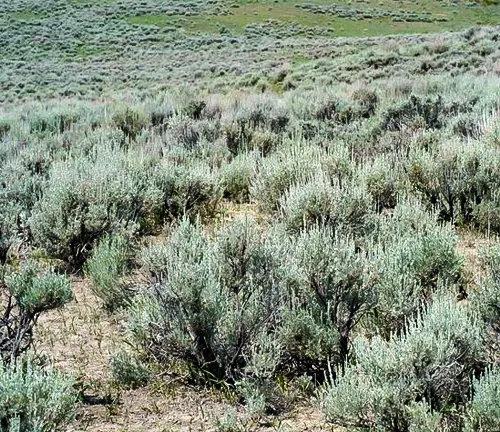
The diverse vegetation of Bighorn National Forest, encompassing a range of tree species, shrubs, and wildflowers, creates a unique and dynamic ecosystem. These plant communities not only define the visual character of the forest but also provide habitat and sustenance for the diverse wildlife that calls Bighorn home.
Fauna
- Elk (Cervus canadensis): The majestic elk (Cervus canadensis) is a prominent inhabitant of the Bighorn National Forest. Thriving in the diverse landscapes, these large herbivores contribute to the forest’s ecological balance. During the mating season or rut, the resonant bugling of bull elks echoes through the mountains, creating a distinctive and memorable soundscape.
- Bighorn Sheep (Ovis canadensis): True to the forest’s name, Bighorn National Forest is home to the iconic bighorn sheep (Ovis canadensis). These agile and sure-footed mammals navigate the steep and rocky terrain with ease. The sight of bighorn sheep scaling the rugged slopes adds a thrilling element to the forest’s wildlife encounters.
- Black Bears (Ursus americanus): The elusive black bear (Ursus americanus) finds refuge within the forest, foraging for food in its diverse ecosystems. While grizzly bears have not inhabited the area since the early 20th century, black bears are widespread, contributing to the forest’s diverse mammalian fauna.
- Mountain Lions (Puma concolor): Stealthy and elusive, mountain lions (Puma concolor) are apex predators in Bighorn National Forest. These solitary big cats play a crucial role in controlling herbivore populations, contributing to the overall health and balance of the ecosystem.
- Mule Deer (Odocoileus hemionus): Mule deer (Odocoileus hemionus) roam the forest, particularly in the lower elevations and meadow areas. Recognizable by their large ears, these herbivores are adapted to the varied vegetation found in Bighorn National Forest.
- Moose (Alces alces): The iconic moose (Alces alces) is another charismatic megafauna species found in the Bighorn National Forest. Often spotted near lakes and wetland areas, moose contribute to the forest’s rich biodiversity and are a sought-after sight for wildlife enthusiasts.
- Coyotes (Canis latrans): Coyotes (Canis latrans) are adaptable predators that inhabit various ecosystems within the forest. Known for their cunning and adaptability, these canids play a role in controlling small mammal populations and contribute to the overall ecological dynamics of Bighorn.
- Pronghorn (Antilocapra americana): Pronghorn (Antilocapra americana), often referred to as “American antelope,” are fleet-footed herbivores that traverse the open grasslands and sagebrush-covered lowlands of Bighorn National Forest. Their unique adaptations make them a distinctive feature of the region’s fauna.
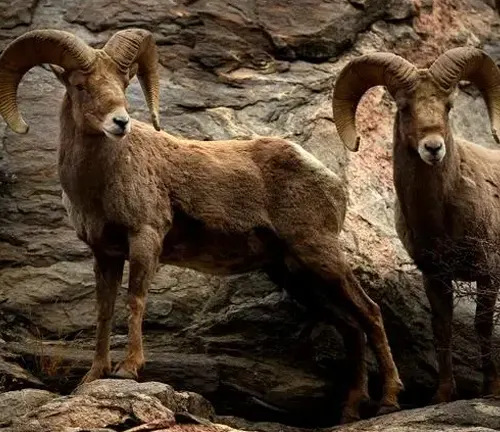
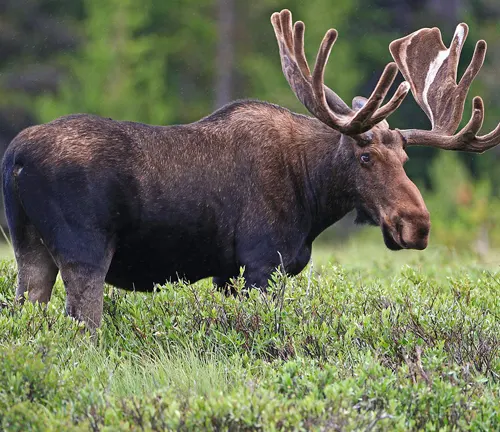
The diverse fauna of Bighorn National Forest contributes to the allure of this natural haven. Whether observing the impressive antlers of elk, the agile movements of bighorn sheep, or the elusive presence of mountain lions, encountering the wildlife in this forest adds a sense of wonder to the overall experience of exploring the American West.
Attractions in Bighorn National Forest
1. Cloud Peak Wilderness

Discover solitude and unspoiled nature in the Cloud Peak Wilderness, spanning 189,000 acres where only foot or horseback travel is permitted. Backpackers are drawn to rugged landscapes, alpine meadows, and crystal-clear lakes for a true wilderness experience.
2. Bighorn Scenic Byway (U.S. Route 14)

Take in the breathtaking beauty of the Bighorn Mountains on the 30-mile Bighorn Scenic Byway. This picturesque drive offers diverse landscapes, from dense forests to expansive meadows, providing easy access to key points of interest within Bighorn National Forest.
3. Medicine Wheel National Historic Landmark

Explore the historical and spiritual significance of the Medicine Wheel, an 80-foot stone circle perched high in the Bighorn Mountains. Accessible via the Medicine Wheel Passage (U.S. Highway 14A), this landmark offers not only cultural insights but also stunning panoramic views.
4. Cloud Peak Skyway (U.S. Route 16)

Embark on the Cloud Peak Skyway, U.S. Route 16, to traverse the highest pass in Bighorn National Forest Powder River Pass at 9,677 feet. This scenic route in the southern section provides unparalleled views of mountain peaks, meadows, and forests.
5. Meadowlark Lake
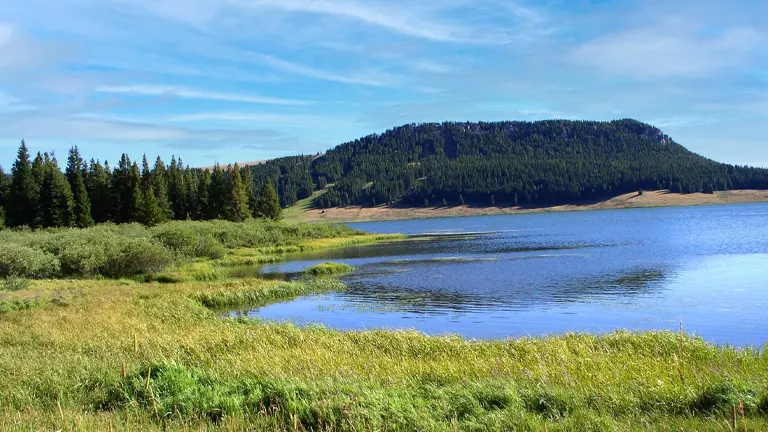
Enjoy serene recreation at Meadowlark Lake, a tranquil area created by a dam in 1936. Fishing, boating, and picnicking opportunities abound in this picturesque setting surrounded by the natural beauty of the Bighorn Mountains.
6. Burgess Junction

Find a central hub at Burgess Junction, where Routes 14 and 14A intersect. This location offers practical amenities, including a ranger station, accommodations, and campgrounds, making it an ideal starting point for exploration.
7. Shell Falls
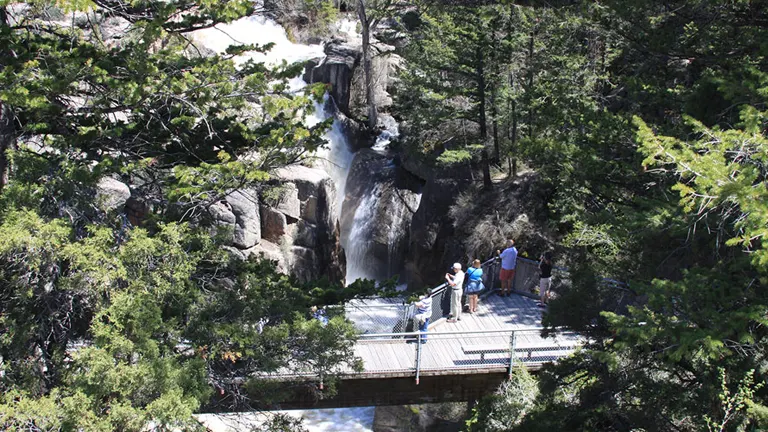
Witness the power of nature at Shell Falls, a stunning waterfall near the eastern boundary of Bighorn National Forest. Easily accessible from the highway, this 120-foot waterfall provides a refreshing stop for travelers and showcases the geological wonders of the region.
These attractions collectively offer a diverse range of experiences, inviting visitors to explore the natural wonders and recreational opportunities within Bighorn National Forest.
Recreational Activities in the Bighorn National Forest
1. Hiking and Backpacking

Bighorn National Forest offers a network of over 1,500 miles of trails, making it a haven for hikers and backpackers. These trails traverse diverse landscapes, from lowland sagebrush to alpine meadows, providing opportunities for both day hikes and extended backpacking adventures. Popular routes include those leading to Cloud Peak, the highest point in the Bighorn Mountains, and the scenic Cloud Peak Wilderness, where the absence of motorized equipment ensures a pristine backcountry experience.
2. Scenic Drives

The forest is crisscrossed by scenic byways such as the Bighorn Scenic Byway (U.S. Route 14) and the Cloud Peak Skyway (U.S. Route 16). These routes offer motorists breathtaking views of mountainous terrain, dense forests, and expansive meadows. Ideal for those seeking a more relaxed exploration, these drives provide access to key attractions within the forest, showcasing the diverse beauty of the Bighorns.
3. Fishing and Boating

Bighorn National Forest features numerous lakes, including Meadowlark Lake and others stocked with trout and diverse fish species. Fishing enthusiasts can cast their lines into clear mountain waters, while boating is a popular activity on certain lakes. These serene water bodies, surrounded by the forest’s natural beauty, create ideal settings for a leisurely day of fishing or boating.
4. Camping

With 32 improved campgrounds scattered throughout the forest, camping is a popular recreational activity in Bighorn National Forest. From developed sites with amenities to more primitive spots, campers can choose their preferred level of immersion in nature. Whether nestled in the forested foothills or situated near a pristine mountain lake, camping allows visitors to fully embrace the tranquility of the Bighorns.
5. Wildlife Viewing
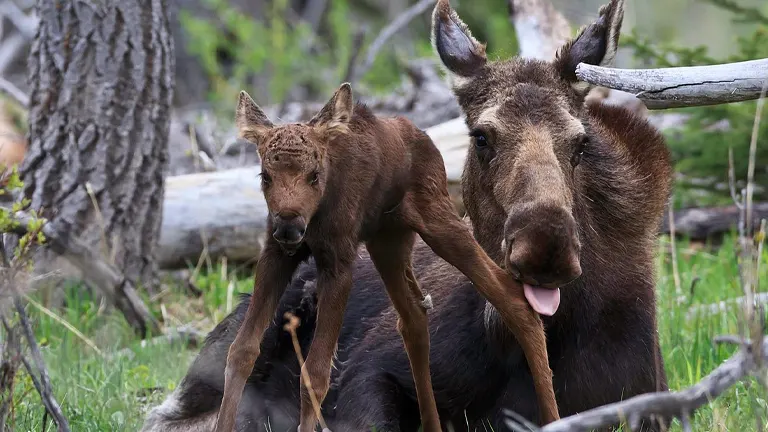
Bighorn National Forest is home to a diverse array of wildlife, including elk, bighorn sheep, black bears, and more. Wildlife enthusiasts can explore the forest’s ecosystems, keeping a watchful eye for these charismatic species. Meadow areas, especially during dawn and dusk, often present opportunities to observe wildlife in their natural habitats, creating memorable experiences for nature lovers.
6. Snowmobiling and Winter Sports

During the winter months, Bighorn National Forest transforms into a winter wonderland. Snowmobiling enthusiasts can explore designated trails, experiencing the forest’s snowy landscapes. Additionally, the forest offers opportunities for cross-country skiing and snowshoeing, allowing winter sports enthusiasts to appreciate the serene beauty of the Bighorns in a different season.
7. Picnicking and Relaxation
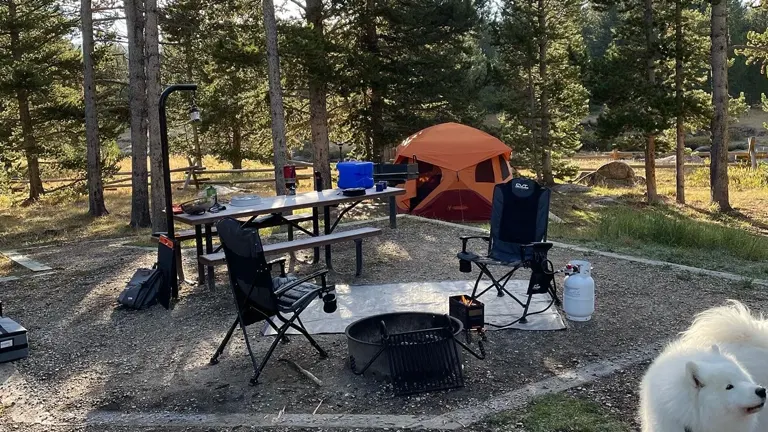
For those seeking a more laid-back experience, Bighorn National Forest provides numerous picnic areas, often situated near scenic viewpoints or along babbling streams. These spots offer a chance to relax amidst the natural surroundings, enjoy a meal, and appreciate the forest’s sights and sounds. Picnicking is an accessible and family-friendly activity for visitors of all ages.
8. Nature Interpretation and Photography
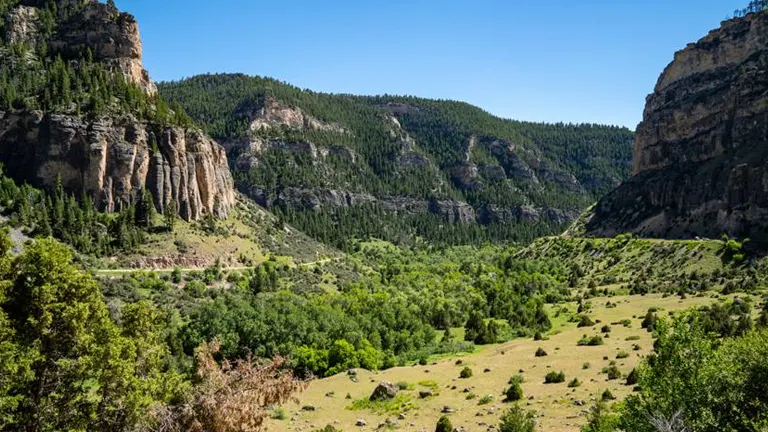
Bighorn National Forest is a treasure trove for nature enthusiasts and photographers. Visitors can embark on interpretive trails, learning about the forest’s ecology, geology, and cultural history through informative signage. The diverse landscapes, from wildflower-filled meadows to dense woodlands, provide ample opportunities for capturing stunning photographs and connecting with the unique character of the Bighorn Mountains.
Bighorn National Forest caters to a wide range of recreational interests, ensuring that visitors can engage with the natural beauty of the area in ways that suit their preferences and skill levels. Whether exploring on foot, enjoying a scenic drive, or participating in water activities, the forest offers a diverse and immersive outdoor experience.
Facilities and Amenities in Bighorn National Forest
- Campgrounds: Bighorn National Forest provides 32 improved campgrounds, offering a range of options for visitors seeking overnight stays. These campgrounds vary in amenities, from basic facilities for those seeking a more rustic experience to sites with more developed infrastructure, including fire rings, picnic tables, and restroom facilities. The diverse camping options cater to different preferences, allowing visitors to immerse themselves in the forest’s natural beauty.
- Visitor Centers: Strategically located, Bighorn National Forest features visitor centers at Burgess Junction and near Shell Falls. These centers serve as informative hubs, providing maps, exhibits, and insights into the forest’s ecology, history, and recreational opportunities. Staffed by knowledgeable personnel, the visitor centers are valuable resources for those looking to enhance their understanding of Bighorn National Forest.
- Ranger Stations: Ranger stations play a crucial role in facilitating communication and assistance within the forest. With locations in Buffalo, Lovell, Sheridan, and Burgess Junction, these stations serve as bases for forest rangers who provide information, guidance, and support to visitors. Additionally, they contribute to the management and conservation efforts of the forest, ensuring a safe and enjoyable experience for all.
- Burgess Junction: Serving as a central hub within Bighorn National Forest, Burgess Junction is strategically located at the intersection of Route 14 and Route 14A. In addition to practical amenities like a ranger station and campgrounds, Burgess Junction offers visitors stunning panoramic views of the surrounding landscapes. This junction serves as both a convenient starting point for exploration and a vantage point for capturing the essence of the forest’s diverse terrain.
- Picnic Areas: Bighorn National Forest provides designated picnic areas, inviting visitors to take a break and enjoy a meal surrounded by nature. These areas are thoughtfully placed in scenic spots throughout the forest, allowing guests to relax and savor their picnic experience amidst the breathtaking landscapes of the Bighorn Mountains.
- Meadowlark Lake Recreation Area: Nestled within Bighorn National Forest, the Meadowlark Lake Recreation Area offers a range of facilities for outdoor enthusiasts. Created by a dam built in 1936, Meadowlark Lake provides opportunities for fishing, boating, and picnicking. The recreation area is equipped with amenities, including a boat ramp, making it a popular destination for those seeking both water-based and lakeside activities.
- Shell Falls Interpretive Site: Near the eastern boundary of Bighorn National Forest, Shell Falls is accompanied by an interpretive site that enhances the visitor experience. The site provides educational displays, allowing visitors to learn about the geological features and natural history of the area while appreciating the beauty of the waterfall. Accessible by a short hike from the highway, Shell Falls Interpretive Site offers an informative stop for those exploring the forest.
- Restrooms and Facilities: Throughout Bighorn National Forest, restroom facilities are strategically placed to accommodate visitors. Whether located at campgrounds, trailheads, or popular attractions, these facilities contribute to the comfort and convenience of guests, ensuring that visitors can enjoy the forest while respecting its natural environment.
Bighorn National Forest is well-equipped with facilities and amenities designed to enhance the visitor experience. From well-maintained campgrounds to informative visitor centers and practical ranger stations, these resources contribute to the accessibility, enjoyment, and conservation of this pristine natural area.
Tips for Visiting Bighorn National Forest
- Check Weather Conditions: Bighorn National Forest experiences diverse weather conditions, ranging from warm summers to cold winters. Before embarking on your visit, check the current weather forecast and be prepared for potential changes in temperature, especially at higher elevations. Layered clothing, sunscreen, and rain gear are advisable to ensure a comfortable and enjoyable experience, regardless of the season.
- Respect Wildlife and Nature: Bighorn National Forest is a haven for diverse wildlife, including elk, bighorn sheep, and black bears. When observing or encountering these animals, maintain a respectful distance to ensure both your safety and theirs. Leave no trace by disposing of waste properly and following the principles of “pack it in, pack it out.” Respect the natural environment by staying on designated trails and adhering to Leave No Trace principles to preserve the beauty of the forest.
- Know Trail Regulations: With over 1,500 miles of trails, Bighorn National Forest offers a variety of hiking experiences. Before hitting the trails, familiarize yourself with trail regulations, including any restrictions on motorized or mechanical equipment, particularly in designated wilderness areas like the Cloud Peak Wilderness. Respect trail signage, stay on designated paths, and be aware of any seasonal closures to protect the delicate ecosystems.
- Carry Essential Supplies: Whether embarking on a day hike or an extended camping trip, ensure you carry essential supplies. Water, snacks, a map, and a compass are crucial items for any outdoor adventure. Additionally, depending on your chosen activity and the season, consider bringing appropriate gear such as sturdy hiking boots, rain jackets, and, in winter, snowshoes or crampons for icy conditions.
- Check Road Conditions: If planning a scenic drive through Bighorn National Forest, like the Bighorn Scenic Byway, be sure to check road conditions beforehand. Certain routes may be seasonal or subject to closures due to weather or maintenance. Information on road conditions can be obtained from local ranger stations or online resources to ensure a smooth and safe journey.
- Understand Camping Regulations: Bighorn National Forest offers numerous campgrounds, each with its own set of regulations. Familiarize yourself with camping guidelines, including reservation requirements, stay limits, and fire regulations. Many campgrounds operate on a first-come, first-served basis, so arriving early is advisable, especially during peak seasons.
- Educate Yourself on Wildlife Safety: While encounters with wildlife are a highlight, it’s essential to be informed about wildlife safety. Carry bear spray in bear country, make noise while hiking to alert animals to your presence, and secure food to prevent attracting wildlife to campsites. Being aware and respectful reduces the risk of negative encounters and ensures the safety of both visitors and the forest’s inhabitants.
- Visit Visitor Centers: Utilize the visitor centers at Burgess Junction and near Shell Falls to gather valuable information about the forest’s ecology, history, and recreational opportunities. Knowledgeable staff can provide updates on current conditions, trail recommendations, and any specific alerts or advisories. Taking advantage of these resources enhances your understanding and appreciation of Bighorn National Forest.
Visiting Bighorn National Forest offers a chance to immerse yourself in the natural beauty of the American West. By following these tips, you can ensure a safe, respectful, and enjoyable experience while preserving the integrity of this pristine wilderness.
Recommendation
I recommend exploring Bighorn National Forest for a captivating blend of natural marvels and historical resonance. This forest, renowned for its varied ecosystems, iconic landmarks, and recreational possibilities, offers a unique and immersive adventure. Indulge in reflective outdoor activities such as hiking and observing wildlife, actively contributing to ongoing conservation efforts. The scenic trails, historic points of interest, and collaborative conservation initiatives make Bighorn National Forest a vital destination for those seeking a harmonious union of nature and recreational exploration.
Conclusion
In summary, Bighorn National Forest, established in 1897, is a testament to the beauty of the American West. Spanning over a million acres, it features scenic mountains, valleys, and alpine tree forests, providing a captivating blend of natural wonders and recreational opportunities. As one of the oldest government-protected forest lands in the U.S., it prohibits motorized equipment in the Cloud Peak Wilderness and offers 1,500 miles of trails, 32 campgrounds, and three scenic byways. Nestled in the Bighorn Mountains between Mt. Rushmore and Yellowstone National Park, the forest showcases breathtaking landscapes and diverse ecosystems, inviting visitors to engage in activities like hiking and fishing. With its rich history and collaborative conservation efforts, Bighorn National Forest beckons those seeking a harmonious connection with nature to explore its pristine wilderness.
FAQs
- Is Bighorn National Forest only for experienced hikers and outdoor enthusiasts?
No, Bighorn National Forest caters to all skill levels. While it offers challenging trails in the Cloud Peak Wilderness for experienced hikers, there are also easier routes and scenic drives suitable for families and individuals seeking a more relaxed outdoor experience. - Can I bring my pets to Bighorn National Forest?
Yes, pets are welcome in many areas of the forest, but they should be kept on a leash for the safety of both wildlife and other visitors. Some specific trails or sensitive ecological areas may have restrictions, so it’s advisable to check with ranger stations for pet-friendly guidelines. - Are there any guided tours available in Bighorn National Forest?
While there are no official guided tours within the forest, ranger-led programs and educational events are often organized. These provide valuable insights into the area’s ecology, history, and conservation efforts. Check with the visitor centers for information on upcoming programs. - Can I camp in Bighorn National Forest without a reservation?
Many campgrounds operate on a first-come, first-served basis, but some do accept reservations. It’s recommended to check the specific campground’s regulations and availability in advance, especially during peak seasons, to ensure a spot for camping. - What is the best time to visit Bighorn National Forest for wildlife viewing?
The best time for wildlife viewing is typically during the early morning or late evening. Spring and fall are also ideal seasons, as animals are more active during these times. Keep a respectful distance and use binoculars or a camera with a zoom lens for a closer look. - Are there any fishing restrictions in Bighorn National Forest?
Fishing is a popular activity in the forest, and there are numerous lakes and streams stocked with trout and other fish species. While most waters are open for fishing, some areas may have specific regulations or seasonal restrictions, so it’s essential to be aware of and adhere to these guidelines. - How do I learn more about the history of Bighorn National Forest?
Visitor centers at Burgess Junction and near Shell Falls offer exhibits and information about the forest’s rich history. Additionally, ranger-led programs often delve into the historical significance of key landmarks and events in the area. - Can I visit Bighorn National Forest in the winter?
Yes, Bighorn National Forest transforms into a winter wonderland, offering opportunities for snowshoeing, cross-country skiing, and snowmobiling. However, road conditions can be challenging, so it’s crucial to check for winter closures and be prepared for snowy and icy conditions.
Bighorn National Forest captivates with its diverse landscapes and rich history. From challenging hikes to serene lakes, it offers a spectrum of experiences for nature enthusiasts. As you leave, the echoes of rustling leaves linger, a reminder of the timeless allure of this untouched wilderness. Until your next adventure, Bighorn National Forest remains an open invitation to explore the beauty of the American West.

Forestry
Forestry Author4 comments
Reading about Bighorn's rich vegetation has me planning my next camping trip already. Nature's diversity never fails to amaze!
Ethan
January 3, 2024 3:19 amThe beauty of Bighorn National Forest's flora is simply mesmerizing. Can't wait to capture those vibrant wildflowers on my next visit!
RajOutdoorEnthusiast
January 3, 2024 3:18 amWow, Bighorn National Forest sounds like a dream! I'm itching to hike those trails and uncover the diverse plant life.



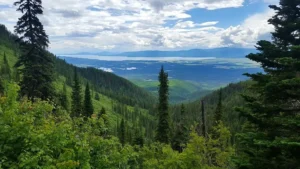
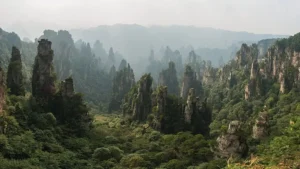
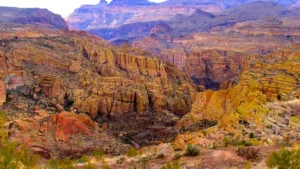


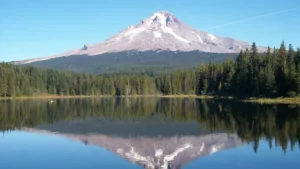


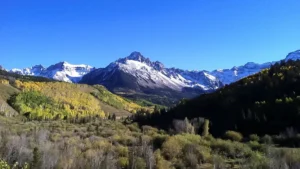

Bighorn National Forest's biodiversity is nature's masterpiece! Can't wait to immerse myself in the greenery and tranquility.
Layla_WanderlustSpirit
January 3, 2024 3:19 am